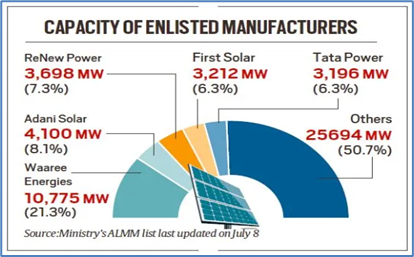Why in News?
The Ministry of New and Renewable Energy (MNRE) reimposed its mandate requiring solar projects to source (photovoltaic [PV]) modules exclusively from a government-approved list of domestic manufacturers starting April 1.
This comes amid concerns over market concentration in India’s solar PV module industry and its potential to drive-up household electricity tariffs.
What’s in Today’s Article?
- Government Initiatives to Bolster Domestic Clean Technology Manufacturing
- Implications of Market Concentration in India’s Solar PV Module Industry
- India’s Renewable Energy Prospects
Government Initiatives to Bolster Domestic Clean Technology Manufacturing:
- The ALMM (Approved List of Model Manufacturers):
- Issued by the MNRE in 2021, it mandates all government-assisted or associated solar projects to use only enlisted modules, effectively barring the use of imported modules in most projects.
- The order aims to enhance energy security by reducing import dependence.
- The order was reimposed recently because the enlisted capacity of around 50 GW is believed to be sufficient and the duty-free import of solar modules from ASEAN countries is detrimental to domestic producers.
- The Production Linked Incentive (PLI) scheme for solar PV modules: Till now, the MNRE has announced incentives for 48.3 GW of module manufacturing capacities under the PLI scheme.
Implications of Market Concentration in India’s Solar PV Module Industry:
- Positive:
- The BCD (Basic Custom Duty of 40% on solar module imports) will help grow the consumption demand of domestically manufactured products.
- Manufacturers anticipate a multifold increase in solar panel installations due to the PM-Surya Ghar Muft Bijli Yojana's goal of installing one crore household rooftop solar panels.
- Furthermore, solar panel manufacturers are also hoping for a policy change in European countries on the lines of the US which may open the European market for India.
- Negative:

- Companies linked to just five manufacturers control nearly half of the current capacity listed on the ALMM.
- Domestic solar modules are now 90% more expensive than imports, with prices reaching 18 cents per watt compared to 9.1 cents for imported modules.
India’s Renewable Energy Prospects:
- Current situation:
- It should be mentioned that India is the 3rd largest energy consuming country and stands 4th for total renewable power capacity additions.
- As of (May) 2024, India’s renewable energy capacity stands at 195.01 GW with solar power capacity of 85.47 GW, wind power of 46.65 GW, small hydro power of 5 GW and large hydro power of around 46 GW.
- At COP26 India announced its plan to achieve the target of 500GW of non-fossil fuel-based energy by 2030.
- Future projections:
- India’s power consumption is growing at around 10%-12% per annum resulting in an additional power demand of 20-25 GW annually.
- This increasing demand combined with the government initiatives may create a multi fold increase in the demand for solar installations.
- Challenges:
- In order to reach the 2030 target, India needs to add about 44 GW annually, requiring an investment of US$ 190-215 billion over seven years.
- According to the Ministry of Commerce & Industry data, the total solar capacity installed in FY 24 was around 15 GW this far.
- Land acquisition and infrastructure development to establish an efficient transmission network are the major challenges that the industry and the government need to address.
- India’s per capita power consumption is only around one third of the global average.










